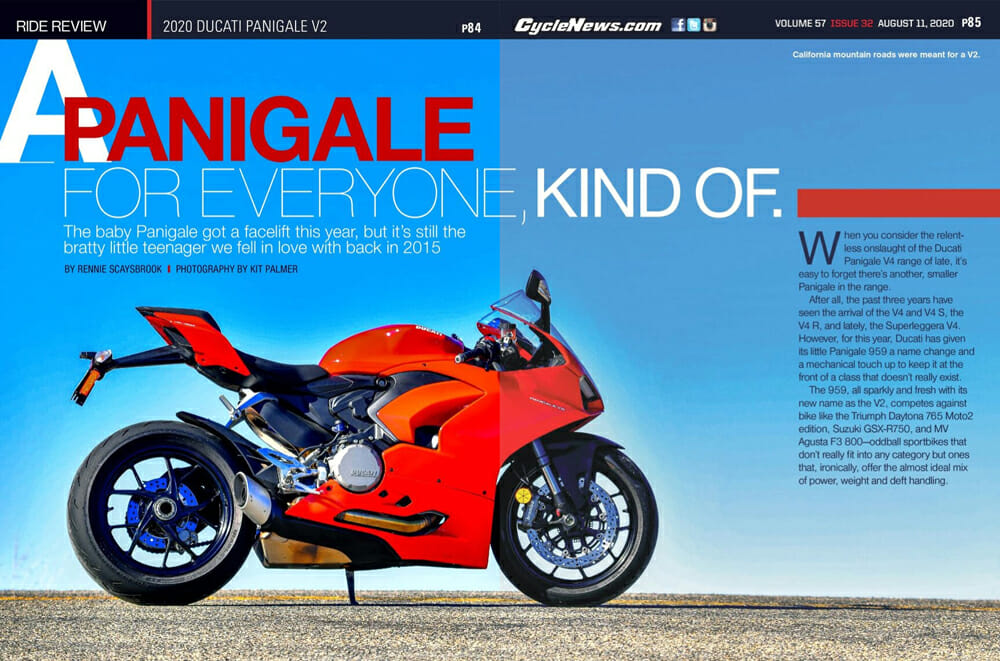Rennie Scaysbrook | August 14, 2020
The baby Panigale got a facelift this year, but it’s still the bratty little teenager we fell in love with back in 2015.
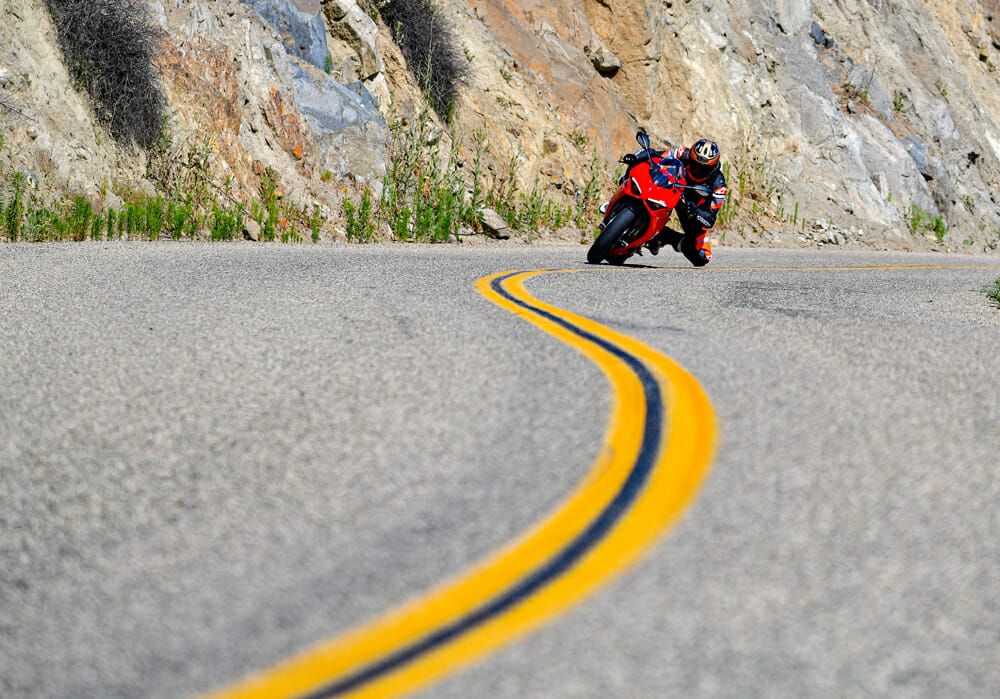 Windy roads, a Panigale V2 beneath you, and the world’s troubles just melt away.
Windy roads, a Panigale V2 beneath you, and the world’s troubles just melt away.
Photography by Kit Palmer
When you consider the relentless onslaught of the Ducati Panigale V4 range of late, it’s easy to forget there’s another, smaller Panigale in the range.
After all, the past three years have seen the arrival of the V4 and V4 S, the V4 R, and lately, the Superleggera V4. However, for this year, Ducati has given its little Panigale 959 a name change and a mechanical touch-up to keep it at the front of a class that doesn’t really exist.
The 959, all sparkly and fresh with its new name as the V2, competes against bike like the Triumph Daytona 765 Moto2 edition, Suzuki GSX-R750, and MV Agusta F3 800—oddball sportbikes that don’t really fit into any category but ones that, ironically, offer the almost ideal mix of power, weight and deft handling.
I first tested the 959 at Valencia, Spain, in 2015 and came away absolutely raving.
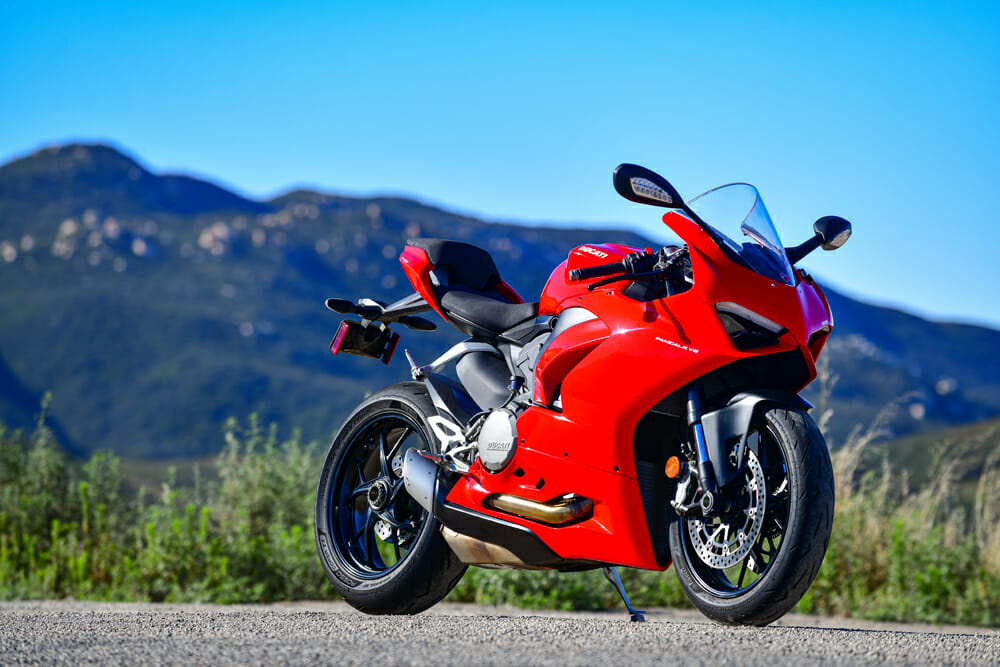 Just like the bigger brother V4, the V2 gets a single-sided swingarm but no winglets, which is a nice change.
Just like the bigger brother V4, the V2 gets a single-sided swingarm but no winglets, which is a nice change.
“The 959 is agile, svelte, easier to master than the 1299 and builds your confidence like a lady,” was a line from a glowing review, and I meant every word of it. That little white Panigale was the kind of sportbike everyone should try, I remember thinking, simply because it didn’t scare the living crap out of the rider each time they sat on it.
The 959 went unchanged until this year, and although the changes are evolutionary, Ducati has still shown their undying love of two-cylinder sport/superbikes. This is the platform that made Ducati who they are, so it’s nice to see they haven’t abandoned it while the V4 rips various holes in time and space around it.
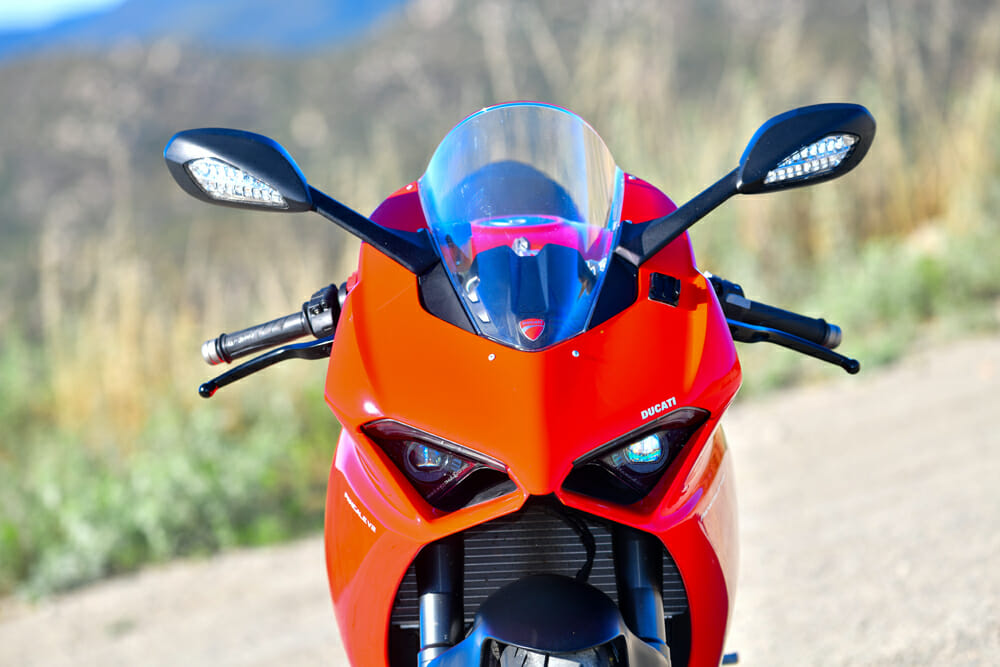 New lights are slimmer than the 959’s and reminiscent of the V4.
New lights are slimmer than the 959’s and reminiscent of the V4.
The V2, as it is now known, gets various updates, including new bodywork and lights that mimic the V4 range (although there are no winglets), new electronics and a new Euro5-compliant motor via the new exhaust system that houses two catalytic converters in the muffler. Ducati has managed to eke out an extra five horsepower from the 955cc engine to give a claimed 155 horsepower at 10,750 rpm, with torque jumping 1.5 lb-ft to 76.7 lb-ft at 9000 rpm.
It’s a raucous occasion when you thumb the V2 starter, especially when you’re in an echoey place like your garage. The sound is visceral, almost violent, a reminder of how loud and downright obnoxious Ducati V-twins were and, in some cases, still are.
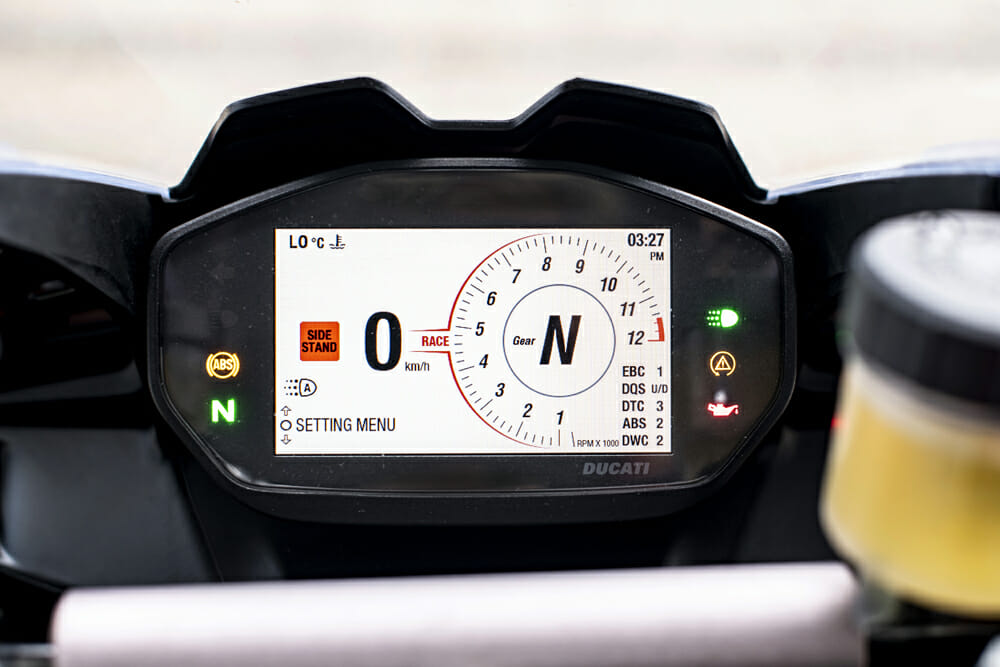 The dash has now been brought up to V4 spec and is pretty much the same.
The dash has now been brought up to V4 spec and is pretty much the same.
The exhaust noise is actually less than the 959 thanks to the new, definitely uglier, exhaust that exits up the right side just under the rider’s boot. It was only a matter of time before the sound police got hold of the 959’s beautiful underslung pipe and, err, underslung it right into the trash bin, but Ducati has done a better job than some at producing an aesthetically pleasing pipe while still getting under noise limits—here’s looking at you, Suzuki GSX-R1000R.
On road, the performance is absolutely as much as anyone needs for a society obsessed with speed limits and their enforcement. While the power won’t rip your arms clean off their sockets, the V2 delivers a sterling experience that brings back memories of a great Ducati V-twin past. If you’ve ridden any of the past decade’s worth of V-twin Ducatis, you’ll remember the often-torrid throttle response that plagued the models. Not so with the V2. It’s a more sedate version of the now gone 1299, but far friendlier in application, and if you gave me the choice of either for a day’s ride, I’m taking the V2.
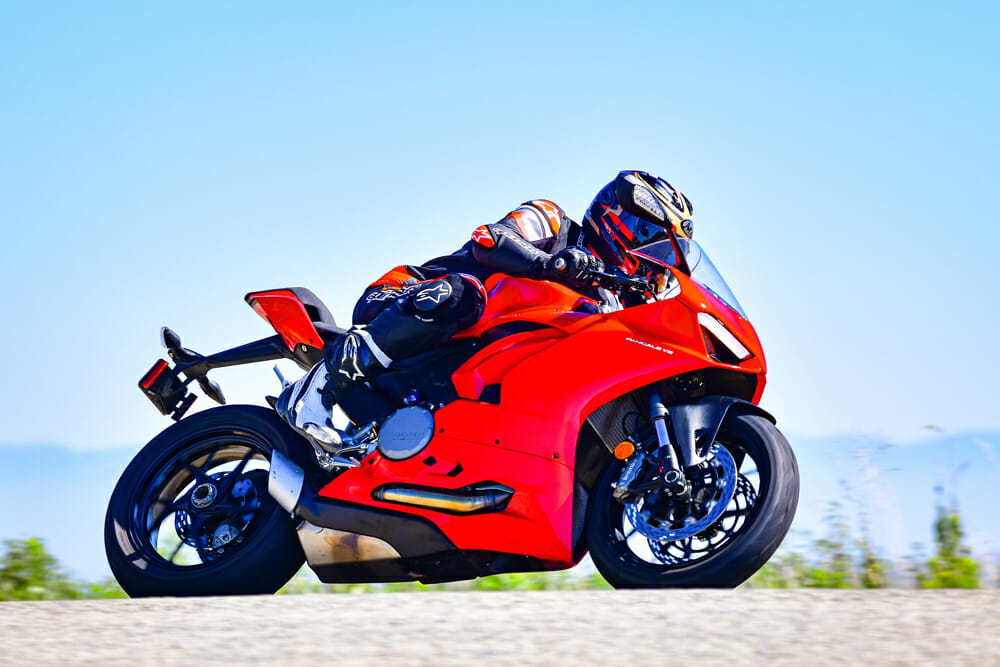 You can see here the angles your knees sit. This isn’t a touring Ducati.
You can see here the angles your knees sit. This isn’t a touring Ducati.
One thing that’s inescapable is the heat. The rear cylinder cooks the rider in traffic on any day above 80 degrees, but once you’re riding at speed with the wind circulating, it’s not too bad.
Chassis-wise, there are changes, but they are not a “reinvent the wheel” deal. I’m probably in the minority in that I quite liked the double-sided swingarm of the 959, but a double is very un-Ducati when it comes to its sportbikes, so it was turfed for a single-sided unit to match its bigger brothers.
You get slight tweaks to the front suspension damping, and the rear preload has been increased, and with a new linkage and a 0.3-inch taller seat at 33 inches, the weight bias has been moved one percent forward to 52 percent—which is something I didn’t notice while on the road, if I’m honest.
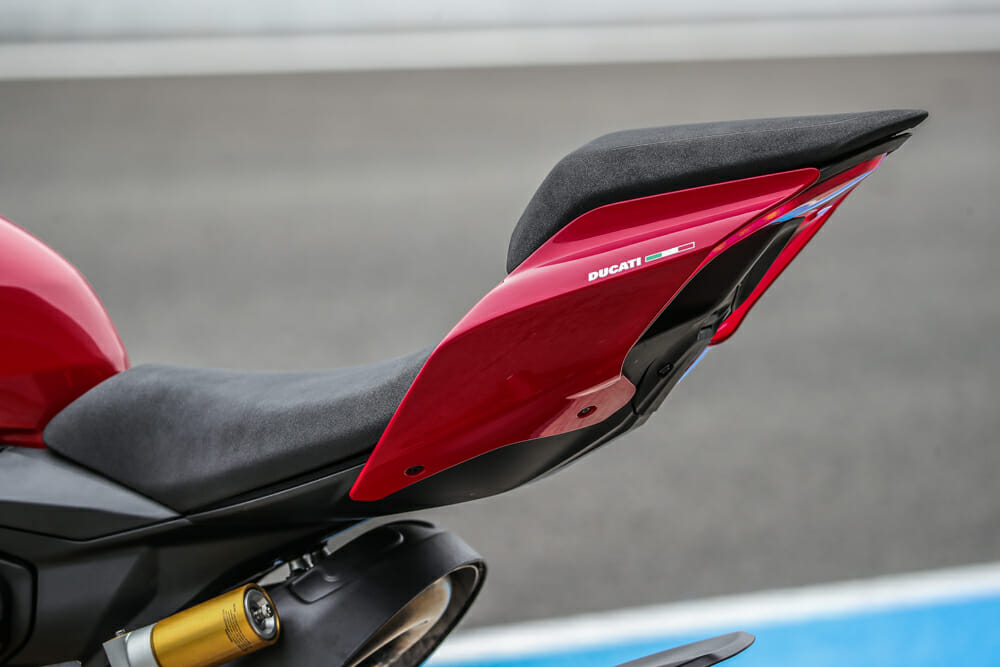 Sharp as a tack.
Sharp as a tack.
That’s always been one of the 959’s/V2’s strong points—stunning agility and turn speed, allowing you to go from one side of the tire to the other almost instantly. In that regard, you could think of the V2 as the ultimate incarnation of the legendary 916. When the 916 came out in 1994, it had 114 horsepower and weighed 450 pounds wet. Move forward 26 years and the V2 pops 155 horsepower and weighs 441 pounds wet. The genes certainly transmitted from dad to son, although the V2 has an impossible task ahead of trying to emulate its famous father, much like any of Michael Jordan’s kids.
The rest of the chassis remains as it was in the aluminum monocoque, which is now a bit of a relic given the V4 uses the Front Frame design. Ducati likely now has more different frame designs than most on their street bikes, with the Front Frame, monocoque, and traditional steel trellis all used on various machines.
That’s a good thing because the V2 monocoque, when matched to the Showa Big Piston Fork and Sachs monoshock offers plenty of nice feel through the seat, pegs and handlebars. You’re never in doubt as to what’s happening beneath you, although it’s still quite stiffly sprung, and the suspension will give you a bit of a jarring when you hit sharp bumps or potholes.
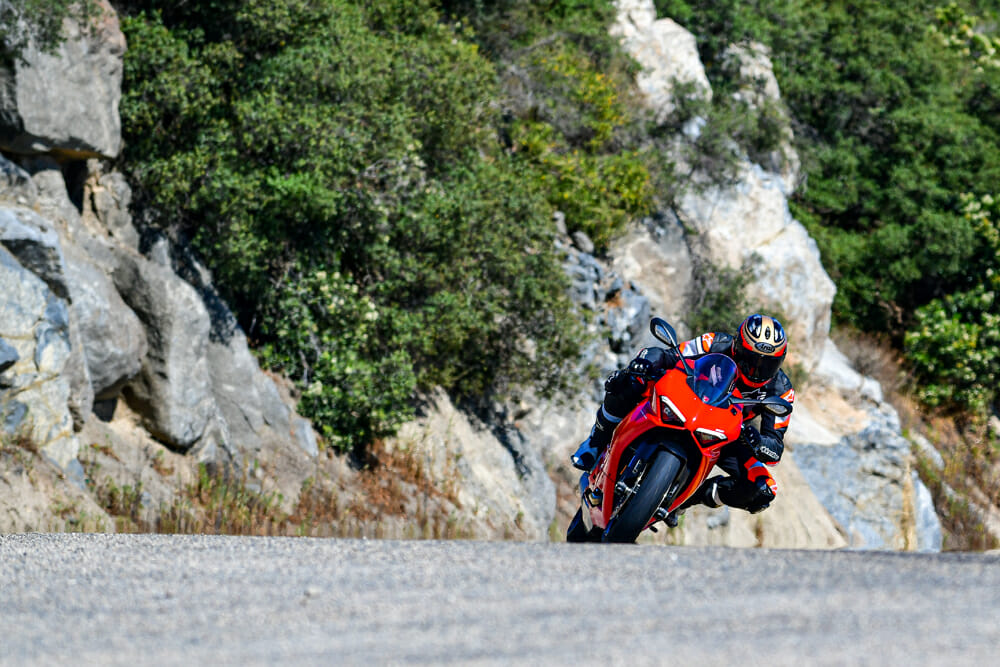 The V2’s chassis talks to you when you throw it on its side. The nervousness and edginess of the V4 are all but gone.
The V2’s chassis talks to you when you throw it on its side. The nervousness and edginess of the V4 are all but gone.
Brembo’s M4.32 four-piston front brake calipers remain on from the 959 days, although they are now matched to Bosch’s Cornering ABS as part of the new electronics suite that includes a six-axis IMU.
It seems odd now that a sportbike comes out without an IMU, and Ducati were some of the first to adopt the technology with the Multistrada half a decade ago. The V2 now joins the V4 with the latest dash and features like Cornering ABS, traction control, wheelie control, up and down quickshift, and engine-brake control. These (except for engine brake control) are all the EVO 2 systems, and, suffice it to say, on the street they work stupendously.
Considering the test we did was purely for road riders and not the track, the electronics never once intervened to the point where I wanted to change from the Sport riding mode (you can have Race, Sport, Street, or your own personalized menu), with level-two traction, level-one wheelie, and level-one engine brake control. Ducati has really got these modes dialed on the V2, and I sense once you find the one you like, you’ll only need to screw with them once you get to the track.
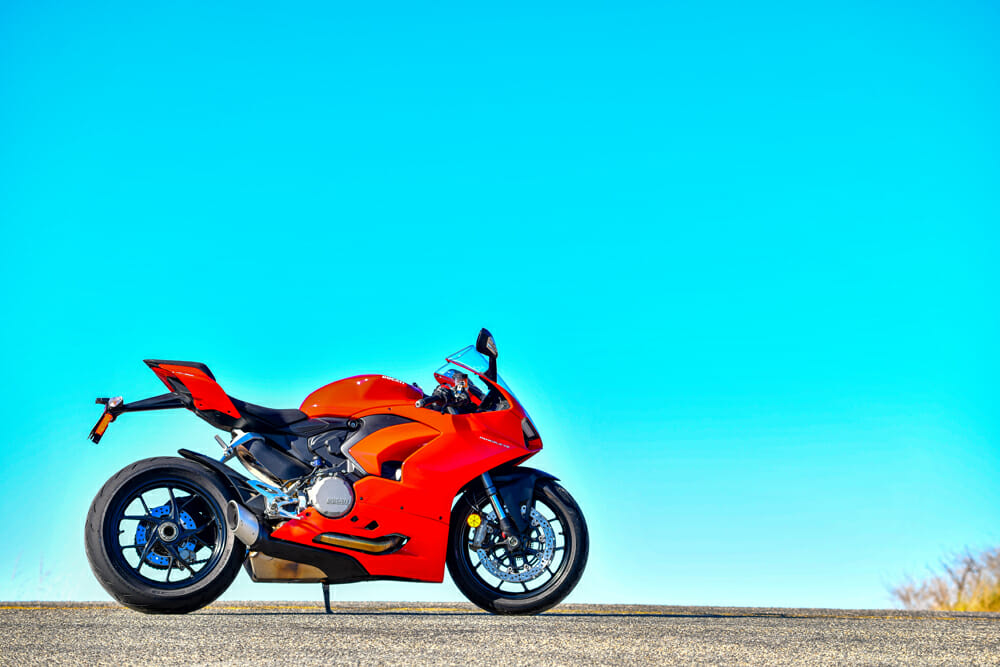 California mountain roads were meant for a V2.
California mountain roads were meant for a V2.
On the road, comfort could be a little better—if you just go and buy a naked bike. This is still a pretty hard-edged sportbike, so if you want to have a few creature comforts, there’s plenty of other bikes in Ducati’s range that’ll fit the bill better than the V2. What the V2 will do is flatter the rider, rather than scare them, as is sometimes the case with the V4. The mix of power, beautiful handling and top-line electronics make for a convincing argument with the V2, and when you throw a little nostalgia into the works in the old V-twin motor platform, the V2 makes for a very fine road sportbike indeed.
Now, if only Ducati North America would bring the Ducati Cup over from the British Superbike Championship for American racers, this could be the ultimate do-it-all sportbike in Ducati’s lineup.CN
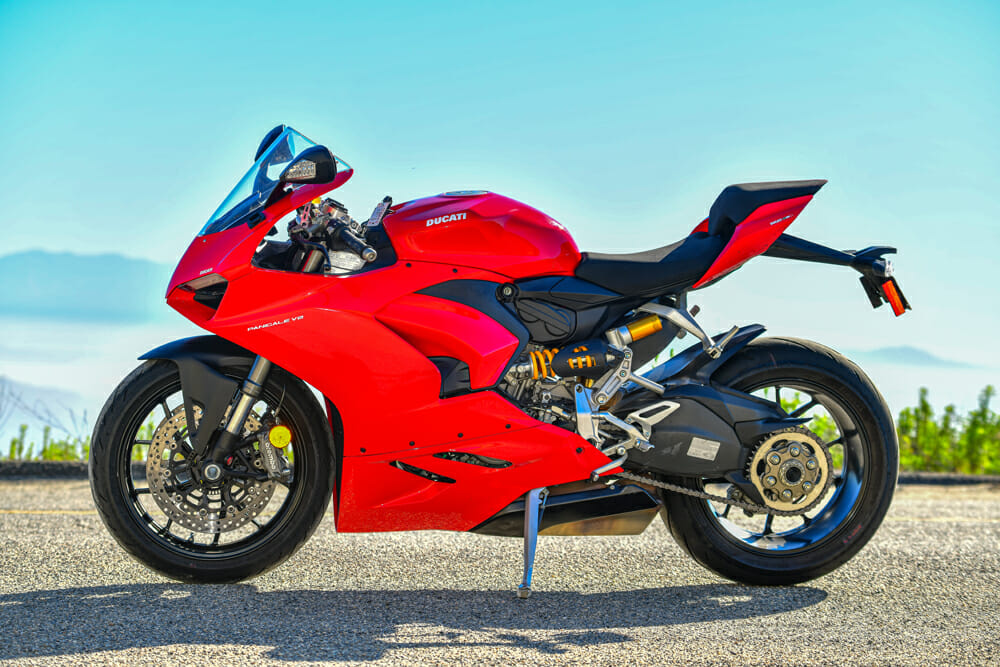
2020 Ducati Panigale V2 Specifications
|
|
| MSRP: |
$16,495 |
| Engine: |
Liquid-cooled, 4-stroke, Superquadro 90° V2, 4-valve-per-cylinder, Desmodromic |
| Displacement: |
955cc |
| Bore x stroke: |
100 x 60.8mm |
| Horsepower (claimed): |
155 hp at 10,750 rpm |
| Torque (claimed): |
76.7 lb-ft at 9000 rpm |
| Compression ratio: |
12.5:1 |
| Fuel system: |
Electronic fuel-injection system, twin injectors per cylinder, full ride-by-wire elliptical throttle bodies |
| Exhaust: |
2-1-2-1 system, with 2 catalytic converters and 2 lambda probes |
| Transmission: |
6-speed with Ducati Quick Shift (DQS) up/down EVO 2 |
| Chassis: |
Monocoque Aluminum |
| Front suspension: |
43mm Showa BPF fork, fully adjustable |
| Rear suspension: |
Sachs shock, fully adjustable, aluminum single-sided swingarm |
| Front brake: |
Dual 320mm semi-floating discs, radially mounted Brembo Monobloc M4.32 4-piston calipers with Cornering ABS EVO |
| Rear brake: |
245mm disc, 2-piston caliper with Cornering ABS EVO |
| Front tire: |
Pirelli Diablo Rosso Corsa II 120/70 ZR17 |
| Rear tire: |
Pirelli Diablo Rosso Corsa II 180/60 ZR17 |
| Rake: |
24° |
| Trail: |
3.7 in. |
| Wheelbase: |
56.5 in. |
| Seat height: |
33.0 in. |
| Fuel capacity: |
4.5 gal. |
| Weight (wet, claimed): |
441 lbs. |
| Color: |
Red |
